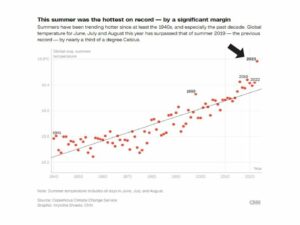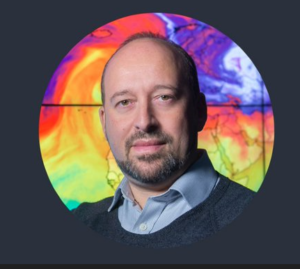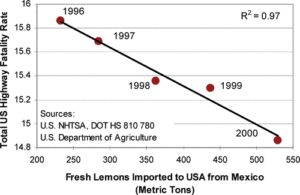Gavin Schmidt is Director of the NASA Goddard Institute for Space Studies. He tells us “Climate models can’t explain 2023’s huge heat anomaly – we could be in uncharted territory.” Meanwhile, so much ice is melting at the Poles, Earth’s rotation is changing. Dr. Chad Greene from NASA’S lab in California reveals Greenland lost even more ice than we knew. Cutting climate science from NASA, this week on Radio Ecoshock.
I’m Alex. Welcome to the show.
Listen to or download this Radio Ecoshock show in CD Quality (57 MB) or Lo-Fi (14 MB)
We know heat and humidity combine into discomfort and then death. Weather forecasts reflect this medical knowledge in the “feels like” temperature. Last week the “feels like” temperature in Rio de Janeiro, Brazil, population 6.7 million people, was 62 degrees C. or 143 degrees Fahrenheit! That is just part of a massive long-lasting heat wave blasting a wide band of South America and right across Africa. It’s punishing heat. In that heat , animals try to get further up the mountain, or toward the Poles just to survive. Humans in their millions will move toward more temperate zones. Are you ready? In a couple of weeks I will replay my interview with British journalist Gaia Vince – all about mass climate migration.
Globally, heat in 2023 blasted by every kind of record, including the oceans. Warmer oceans is a big deal – for fisheries and plant life, coral, and melting glaciers from the bottom. So far, record land and ocean heat continues into 2024. Will that continue? Is this the new normal. That is very hard to predict. Let’s go to the NASA expert who tried to predict global weather every year.
GAVIN SCHMIDT –
THE NEW SPIKE IN HEAT
People in many parts of the world are suffering through extreme heat. The hottest year so far was 2023. The heat is still rolling in 2024, on land and sea. Scientists are scrambling to find out why.

One of the top science journals in the world, Nature, just published this article: “Climate models can’t explain 2023’s huge heat anomaly – we could be in uncharted territory.” The author is the Director of NASA’s Goddard Institute for Space Studies, Gavin Schmidt. Since taking over from James Hansen in 2014, Schmidt continues research, with peer-reviewed publications galore, and still makes time to communicate.

Listen to or download this 25 minute interview with Gavin Schmidt in CD Quality or Lo-Fi
Gavin begins his Nature article:
“When I took over as the director of NASA’s Goddard Institute for Space Studies, I inherited a project that tracks temperature changes since 1880. Using this trove of data, I’ve made climate predictions at the start of every year since 2016. It’s humbling, and a bit worrying, to admit that no year has confounded climate scientists’ predictive capabilities more than 2023 has.
For the past nine months, mean land and sea surface temperatures have overshot previous records each month by up to 0.2 °C — a huge margin at the planetary scale. A general warming trend is expected because of rising greenhouse-gas emissions, but this sudden heat spike greatly exceeds predictions made by statistical climate models that rely on past observations. Many reasons for this discrepancy have been proposed but, as yet, no combination of them has been able to reconcile our theories with what has happened.”
James Hansen and Leon Simons say the spike was pushed by new regulations to cut ship emissions, leading to less cloud formation over the big Pacific shipping lanes between Asia and North America. My own note on this: In his later years, James Hansen’s new post claims the spike in warming is definitely caused by only two things: the El Nino and reduction in ship emissions. That seems like an over-simplification to me. A number of scientists have fired back. Notably Dr. Michael Mann from Penn State says ship emissions could only account for a tiny fraction of the spike and El Nino was not enough. The editorial in Nature by Gavin Schmidt covers several possibilities but also concludes ship emissions could not be enough.
Planet is warming ~0.03C/year. Aerosols (see below) account for ~1/8 of that, i.e. ~0.004C/year. La Nina/El Nino transition led to ~0.5C warming during past year, 100 x as much warming as aerosols.
It is absolutely absurd to attribute the warming spike to aerosols. https://t.co/JQbWAJymWg pic.twitter.com/q9b948p2Fk
— Prof Michael E. Mann (@MichaelEMann) March 30, 2024
SOCIAL PANIC
On social media, including X or Twitter, Gavin counters wrong or misunderstood information, sometimes from other scientists. Schmidt and other climate scientists perform the same role at realclimate.org – like his recent post on “More Solar Shenanigans”. Gavin monitors bad science.
In a world of climate doomers, Gavin has been one of the calmer heads. As Michael Mann says, there are plenty of real things to worry about. His “science-please” approach is one of the reasons I find Gavin’s questions about a possible climate shift even more troubling.
MELTWATER: THE NEW PLAYER
A recent study led by Chad Greene of NASA (second interview below) found ice loss from Greenland has been 20% greater than previously assumed. Gavin Schmidt led a paper published in December 2023 in Geophysical Letters, saying glacial meltwater is now sufficient to change natural systems, or as they titled it “Anomalous Meltwater From Ice Sheets and Ice Shelves Is a Historical Forcing.” Climate models, scientists and all of us now need to readjust to a new significant player: the big flow of fresh water pouring off glaciers at both Poles and other glaciers in Asia and South America.
SEE ALSO GAVIN’S TWO PART BLOG AT REAL CLIMATE ON THIS “UNCHARTED TERRITORY”
As you heard from Dr. Schmidt in our interview, scientists are still guessing what pushed the temperature up these past 12 months – beyond what models – or any of us – expected. Until we get those answers, it will be harder to predict what happens next. Has climate change accelerated? That would not be surprising considering human fossil fuel and agriculture emissions are still increasing big-time. Or will 2025 go into a few years of cooler El Nino, so global average temperatures go back down below the 1.5 danger level again? We may have to wait and see.
My guess, as a long-time science journalist, is that climate and its impacts may not grow on a curve upward. Nature can move in steps, passing the tipping points you heard so much about. Studies of rocks and fossils tell us relatively quick radical change has happened in the past. But humans are altering the atmosphere, land and oceans much faster than almost anything in Earth’s history, other than chains of volcano eruptions or asteroid hits. This is the big experiment with living and physical systems with a lot of moving parts. We can’t go back and we don’t get a second chance.
================
GREENLAND MELT ALERT
CHAD GREENE
You know Greenland is losing a lot of ice. Will it surprise you to learn it is worse than we thought, more than the best climate models assume. New in 2024, the study “Ubiquitous acceleration in Greenland Ice Sheet calving from 1985 to 2022.” This could have serious consequences, including ocean currents warming countries in the North Atlantic.

Here to explain is Lead Author Dr. Chad A. Greene. He is a scientist with NASA’s Jet Propulsion Laboratory in Pasadena.
Listen to or download this 25 minute interview with Chad Greene in CD Quality or Lo-Fi
Greene has a lot of on-site experience, onboard aircraft over Antarctica and expedition ships in the Arctic. On the side, he writes the code for open-source tools for Earth measurements. He is an editor of the Proceedings of the National Academy of Sciences.
The Abstract for this paper says:
“Our results indicate that, by neglecting calving-front retreat, current consensus estimates of ice-sheet mass balance have underestimated recent mass loss from Greenland by as much as 20%. The mass loss we report has had minimal direct impact on global sea level but is sufficient to affect ocean circulation and the distribution of heat energy around the globe.”
There are a lot of factors that could be driving increasing loss of ice at the “terminus” – at the end of the glaciers. Almost all the fast-moving ice streams in Greenland terminate in the sea. Out of many, many possible drivers (like slope of land below, surface run-off, etc.) this team finds one common denominator: how much does the ice expand during winter and shrink back during summer? The more variable seasonal developments are, the more ice that system is losing. This team calls that seasonality a good determinant for climate sensitivity.
The paper says:
“Seven of the eight glaciers with the largest seasonal mass variability in Greenland are among the eight glaciers that have lost the most mass to long-term retreat since 1985.”
Not all glaciers shrink and regrow with each summer or winter season. The four land-based glaciers they checked did not have a seasonal cycle – indicating interaction with the sea is a key factor in that advance and retreat during season changes.
RISK TO AMOC and WEATHER ACROSS EUROPE
Although only a fraction of the 500 Gt or so ice flowing off Greenland each year, the 43 Gt. new found ice when terminus retreat and seasonality is accounted for, may be the extra that tips or slows the Atlantic Meridional Overturning Circulation (which includes the Gulf Stream). The paper says:
“The addition of more than 1,000 Gt of freshwater to the North Atlantic Ocean since 1985 provides a buoyancy force that could strengthen the coastal currents of Greenland, change the course of future ice-ocean interactions and weaken the Atlantic Meridional Overturning Circulation (AMOC). The out-of-balance anomalies we report are modest in comparison with the approximately 500 Gt of ice that flows from the GrIS each year, but there is some concern that any small source of freshwater may serve as a ‘tipping point’ that could trigger a full-scale collapse of the AMOC, disrupting global weather pat-terns, ecosystems and global food security; yet, freshwater from the glacier retreat of Greenland is not included in oceanographic models or estimates of state at present. “
NOTE: MELTING ICE FROM THE POLES IS EVEN CHANGING EARTH’S ROTATION AND TIME
TWO MORE BIG QUESTIONS:
I have two more bonus questions for Dr. Chad Greene, answered by email. First, if only sea terminus glaciers have seasonal variation, and seasonal variation reflects climate sensitivity, where does that leave land-terminus glaciers? Are they less sensitive, do they lack an indicator, or are they the same as sea terminus glaciers?
Chad answers:
“Most glaciers in Greenland terminate at the ocean, so our sample set of land-terminating glaciers is pretty small. The changes we do see at land-terminating glaciers tend to be less dramatic than the changes we see at marine-terminating glaciers because marine-terminating glaciers are directly acted on by powerful ocean forces. Warm water can melt ice much more efficiently than warm air can, and ocean processes can enhance the effects of atmospheric-driven processes like surface runoff.”
AI FOR CLIMATE SCIENCE?
Second, as a Big Data guy: currently scientists ask questions of big data, often assisted by “machine learning” or perhaps nascent AI. Do you think AI scanning constantly over data may come up with new questions? Will it identify far-flung relationships like teleconnections we never suspected?
Chad replies:
“We’re still at the point where scientists are coming up with the questions, and ML/AI are just tools to help answer the questions—That is, AI/ML algorithms aren’t coming up with the questions to ask. AI/ML techniques can be extremely effective at finding relationships in data, but the algorithms generally stop short of answering why any particular relationship exists. In other words, AI/ML techniques are generally better at finding correlations than explaining causation. ML/AI may find some apparent far-flung teleconnection, but much like the relationship between lemon imports and US highway fatality rates, understanding the connection between potential drivers of glacier change and the response we see in Greenland requires a great deal of investigation to understand what’s a true connection and what’s just a coincidence.”
Well sure, the lemons and U.S. highway deaths fallacy! I mean… what? That’s what I get for asking a NASA scientist questions above my pay-grade. It took a deep dive to find this December 2007 paper “The Trouble with QSAR (or How I Learned To Stop Worrying and Embrace Fallacy” by Stephen R. Johnson.

But QSAR? More digging reveals you don’t really need to know. QSAR was a predictive theory in chemistry about corresponding structures. Despite a lot of work and publications, it did not work out. Chad basically says AI may find many similar patterns that are coincidences. So far, it takes a trained human to know what is important and perhaps track down the causes.
However, some important science began with co-relations and may develop the mechanical causes only later. For example, Dr. Jennifer Francis at Rutgers discovered relationships between the amount of sea ice and snow cover in the Arctic, and the waviness of the Jet Stream. In her early work, she did not explain a cause, just the observations. Other teleconnections between events – even stretching thousands of miles or kilometers – have been discovered. A few papers have established probability chains of events behind those connected changes.
WILL AI ASK THE QUESTIONS?
Chad is the second scientist to insist humans will ask the questions and then use AI or machine learning will search after relevant data. I’m not so sure. Perhaps within a few years, or ten years, I think artificial intelligence will begin to formulate important and useful questions and then find answers. This could happen in biotech, in medicine, space studies or any human interest, including climate science. But will those results, or the question, contain false data or assumptions, currently called “hallucinations”?
The risk is: only another artificial intelligence could verify the work. Humans cannot track or document the functioning of Artificial Intelligence. There are no thoughts or linguistic expression in that cloud of electronic activity, just math, algorithms, and flows of digital data. We cannot follow.
Good luck to us all. I’m Alex Smith.
Thank you for listening, and caring about our world.